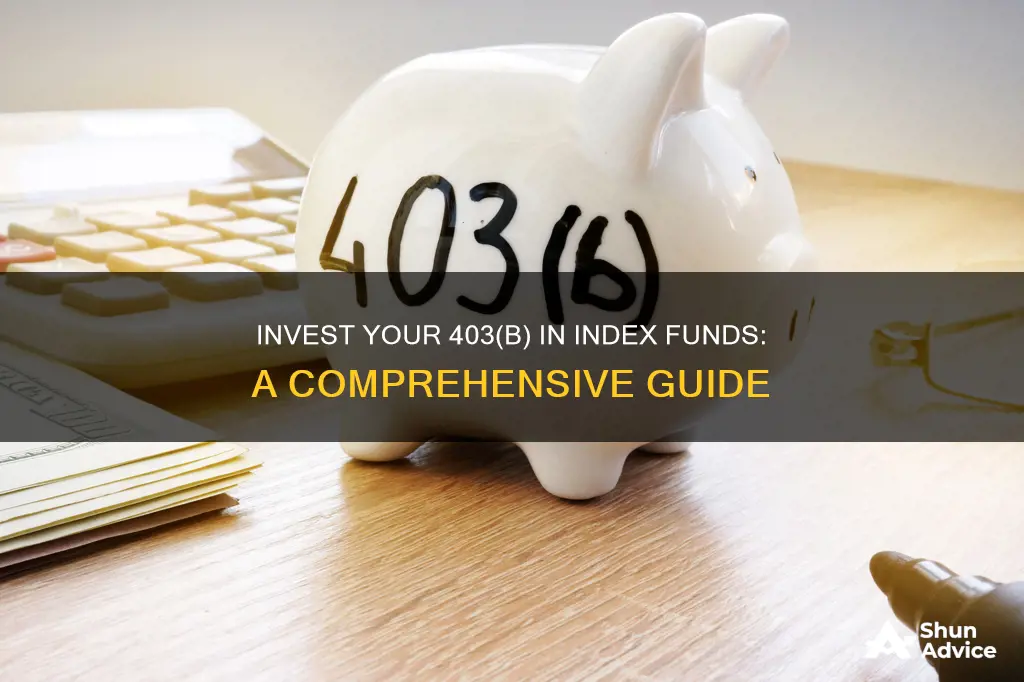
A 403(b) is a tax-advantaged retirement plan designed for non-profit organisations and certain government entities. It is similar to a 401(k) but with some differences. If you are saving for retirement with a 403(b) account, it is important to know how to make the most of it. This includes knowing how to invest your money effectively, such as in inexpensive, broad-market stock index funds for long-term gains. Index funds are a collection of like-minded assets that are typically the least expensive option in any asset class. They offer low fees because they aim to look like a pre-defined index, which means there are fewer fund managers and analysts required to manage the fund compared to an actively managed fund. Index funds can also provide precise diversification.
What You'll Learn

Understand the risks and potential benefits of different investment options
When investing for a long-term goal like retirement, it is generally recommended to focus on stocks, as they have the highest potential for generating returns that outpace inflation. However, it is also important to diversify your portfolio by adding some bonds or cash to reduce overall volatility.
Risk Tolerance and Investment Horizon
Before allocating your investments, it is crucial to consider your risk tolerance, or how comfortable you are with market fluctuations, and your investment time horizon, or how long you plan to invest before needing the money. Diversifying your portfolio across various asset classes, also known as asset allocation, is a popular strategy to moderate the inevitable ups and downs of investing.
A common rule of thumb is that the longer your investment horizon, the more weighted your portfolio should be towards stocks. Conversely, as you get closer to retirement, it is generally advisable to shift towards fixed investments. It is wise to reallocate your portfolio annually to align with your changing goals.
Index Funds
Index funds, which passively track established indices, are a popular investment choice due to their low fees and strong performance relative to their more actively managed counterparts. They eliminate the need to compensate professional money managers with high fees and tend to outperform these funds over time. Examples of well-known indices include the S&P 500, the Dow Jones Industrial Average, and the Russell 2000.
Target-Date Funds
Target-date funds, also known as age-based, life-cycle, or fire-and-forget funds, are a type of mutual fund that simplifies the process of saving for retirement. These funds automatically adjust their asset allocation based on the investor's estimated retirement date, gradually shifting from stocks to safer fixed investments as the target date approaches. This approach takes the emotion out of investing, which is often cited as a reason for poor investment decisions.
Target-date funds are designed to be the sole investment in a portfolio, as mixing them with other funds can disrupt proper diversification. They are widely available with low fees, making them an appealing option for both beginner and veteran investors.
Annuities
A 403(b) plan, also known as a Tax-Sheltered Annuity (TSA) plan, offers the option of investing in annuities. However, financial advisors often recommend against annuities in 403(b) plans and other tax-deferred investment plans. Annuities are designed to provide tax-deferred growth, which is redundant in a tax-deferred investment plan. Additionally, annuities often charge high fees, which can detract from investment performance, and may include complex fine print and restrictive surrender charges.
While variable annuities offer a variable payout based on the performance of underlying investments, fixed annuities offer a guaranteed payout, making them a more conservative option.
Best Debt Funds to Invest in Now
You may want to see also

Choose between passive and active funds
When choosing how to invest your 403(b) plan, you may be faced with the decision of whether to choose passive or active funds. Here are some key points to consider when making that choice:
Passive Funds
Passive funds, also known as index funds, are a popular choice for investors due to their low fees and strong performance. Index funds aim to replicate the performance of a particular stock market index, such as the S&P 500. They are considered a passive investment strategy because they do not require active management, and their goal is simply to match the performance of the index they track.
- Lower fees: Index funds generally have lower fees than actively managed funds because they require fewer fund managers and analysts. Lower fees can translate to higher returns over time.
- Strong performance: Despite their passive nature, index funds have consistently outperformed actively managed funds. This is partly due to their lower fees, but also because it is challenging to consistently pick stocks that outperform the market.
- Precise diversification: The components of passive indexes are readily available, so you know exactly what you are investing in. This makes it easier to achieve the desired level and type of diversification in your portfolio.
Active Funds
Active funds, on the other hand, are managed by professionals who actively select investments with the goal of outperforming the market. These funds usually come with higher fees to compensate for the expertise and time required to actively manage the fund.
- Potential for higher returns: Active funds have the potential to outperform the market and provide higher returns. However, it is important to note that this is not always the case, and consistently picking stocks that beat the market is extremely difficult.
- Higher fees: Active funds typically charge higher fees than passive funds. These fees can eat into your returns over time, so it is important to ensure that the fund justifies its fees through strong performance.
- Active management: Active funds may be more suitable for certain types of investments or strategies. For example, funds focused on small or mid-cap companies, special situations, or specific industries may benefit from active management.
Making the Choice
When deciding between passive and active funds for your 403(b) plan, it is important to consider your investment goals, risk tolerance, and time horizon. If you are seeking a simple, low-cost option, passive funds may be the better choice. On the other hand, if you are willing to take on more risk and pay higher fees for the potential of higher returns, active funds may be more suitable. Additionally, you may choose to combine passive and active funds in your portfolio to achieve a desired level of diversification and performance.
Fidelity Index Funds: Smart, Secure, Long-Term Investment Options
You may want to see also

Diversify your portfolio
When it comes to investing, diversification is key. Diversification is a management strategy that blends different investments in a single portfolio. The idea is that a variety of investments will yield a higher return and lower risk.
Spread the Wealth
Don't put all your eggs in one basket. Equities offer the potential for high returns, but don't put all your money in one stock or one sector. Consider investing in a handful of companies you know and trust and even use in your day-to-day life. You can also invest in commodities, exchange-traded funds (ETFs), and real estate investment trusts (REITs). Think beyond your home base and go global to spread your risk and increase your potential rewards.
Consider Index or Bond Funds
Index funds or fixed-income funds can be a great addition to your portfolio. Investing in securities that track various indexes is a wonderful long-term diversification investment. By adding some fixed-income solutions, you further hedge your portfolio against market volatility and uncertainty. These funds try to match the performance of broad indexes, reflecting the bond market's value. Index funds also often come with low fees, which means more money in your pocket. However, one potential drawback is their passively managed nature, which can be suboptimal in inefficient markets.
Keep Building Your Portfolio
Add to your investments regularly. If you have a substantial amount to invest, consider using dollar-cost averaging to smooth out the peaks and valleys created by market volatility. This strategy involves investing the same amount of money over a period of time to reduce your investment risk. With dollar-cost averaging, you'll buy more shares when prices are low and fewer when prices are high.
Know When to Get Out
While buying and holding and dollar-cost averaging are sound strategies, it's important to stay current with your investments and overall market conditions. Know what is happening to the companies you invest in so you can tell when it's time to cut your losses, sell, and move on to your next investment.
Keep an Eye on Commissions
Understand what you are getting for the fees you are paying. Some firms charge monthly fees, while others charge transactional fees, which can add up and chip away at your bottom line. Be aware of any changes to your fees and shop around for the best deal.
Diversification Tips for 403(b)s
When investing for retirement, you typically want to emphasise stocks, which have the best chance of generating returns that outpace inflation. Adding some bonds or cash to your mix can help reduce volatility. You can use asset allocation and retirement planner calculators to determine the best mix of stocks, bonds, and cash for your retirement money.
Additionally, consider the following:
- Risk tolerance: How well do you handle market fluctuations?
- Investment time horizon: How long until you need the money?
- The longer your investment horizon, the more your portfolio should be weighted towards stocks. Conversely, the closer you are to retirement, the more your portfolio should be weighted towards fixed investments.
- Target-date funds are a great option for retirement savings as they automatically adjust asset allocation over time, becoming more conservative as the target retirement date approaches.
- Keep fees low. Over long periods, even small differences in fees can amount to thousands of dollars. Index funds tend to have lower fees than actively managed funds.
Floating Rate Funds: A Smart Investment Strategy
You may want to see also

Consider fees and charges
When investing in index funds through a 403(b) plan, it is important to pay attention to fees and charges. While index funds are generally a low-fee option, there can be variations, and fees can add up over time, eating into your investment returns. Here are some things to consider:
Understand the Fees Involved
Firstly, it is important to understand the different types of fees associated with 403(b) plans and index funds. These may include expense ratios (annual fees), management fees, transaction fees, and other potential charges. Be sure to read the fine print and understand all the costs involved.
Compare Fees Across Different Index Funds
Not all index funds have the same fee structure. Funds that replicate major indexes like the S&P 500 or the Russell 1000 are typically very inexpensive. However, niche index funds based on new or specialised indexes can be more expensive than traditional index offerings and may even surpass the fees of actively managed funds. It is important to do your research and compare fees before selecting a fund.
Consider the Benefits of Low-Cost Index Funds
Index funds are passively managed, meaning they aim to replicate the performance of a particular index. This passive approach generally results in lower fees compared to actively managed funds, which aim to outperform the market. Lower fees can translate to higher returns over time, as more of your money is invested and compounding rather than being paid out in fees.
Be Wary of Annuities
Annuities are complex financial products that are sometimes offered within 403(b) plans. Annuities often come with high fees and can provide lower returns than other investment options. Additionally, they may have strict rules regarding early withdrawals, limiting your flexibility. While fixed annuities may be suitable for conservative investors, variable annuities can be risky and may not be worth the fees.
Evaluate Target-Date Funds Carefully
Target-date funds, which adjust their asset allocation based on your selected retirement date, can be a good option for hands-off investors. However, these funds may charge a fee in addition to the fees associated with the individual funds within the target-date fund. Be sure to understand the glide path and all associated expenses before selecting a target-date fund.
Monitor Fees Over Time
Fees may change over time, so it is important to regularly review the fees associated with your 403(b) plan and the index funds you are invested in. Additionally, be on the lookout for any changes in the fund's structure or investment strategy that could impact fees. Staying informed will help you make adjustments as needed to keep fees low.
U.S.A.A. Mutual Funds: Where to Invest Wisely
You may want to see also

Decide on a ratio of stocks to bonds
When deciding on the ratio of stocks to bonds in your 403(b) plan, it's important to consider your risk tolerance, investment time horizon, and overall financial goals. Here are some key points to keep in mind:
Risk Tolerance
How comfortable are you with market fluctuations? Stocks generally offer a higher potential for returns but come with higher risks. On the other hand, bonds are considered a more stable investment but with lower returns. If you have a high-risk tolerance and are comfortable with potential short-term losses, you may want to allocate more towards stocks. If you prefer a more conservative approach, investing more in bonds can provide a cushion against market volatility.
Investment Time Horizon
The length of your investment horizon plays a crucial role in determining your stock-to-bond ratio. If you're investing for the long term, such as for retirement, a heavier weighting towards stocks is often recommended, as they have a better chance of outpacing inflation over time. As you get closer to retirement, you may want to gradually shift towards a higher percentage of bonds to preserve your capital and generate more stable returns.
Financial Goals
Consider your financial goals and the level of returns needed to achieve them. Stocks typically offer higher returns over the long term, making them ideal for funding long-term goals like retirement. Bonds, while generally lower-return investments, can provide a source of stability and income for shorter-term goals.
Asset Allocation Strategies
There are various strategies for allocating your portfolio between stocks and bonds. Here are a few common approaches:
- Target-Date Funds: These funds automatically adjust their asset allocation based on your selected retirement date. They are typically more heavily weighted towards stocks when you're farther from retirement and gradually shift towards more bonds as the target date approaches.
- Rule of Thumb: A common rule of thumb is to subtract your age from 100 to determine the percentage of stocks to hold. For example, if you're 30 years old, you would hold 70% stocks and 30% bonds. However, with people living longer, some experts now suggest using 110 or even 120 minus your age as the stock allocation.
- Warren Buffett's 90/10 Strategy: Warren Buffett, a renowned investor, has recommended a 90% allocation to low-cost stock index funds and 10% to short-term government bonds. While this approach may be riskier for the average investor, it underscores the importance of low fees and the potential benefits of a stock-heavy portfolio.
Remember, there is no one-size-fits-all approach to determining your stock-to-bond ratio. It's essential to carefully consider your personal circumstances, investment goals, and risk tolerance when making this decision.
Mutual Funds: Where Are Your Investments Going?
You may want to see also
Frequently asked questions
A 403(b) is a tax-advantaged retirement plan for employees of non-profit organisations, like schools, churches and charities, as well as some public-sector workers such as teachers.
You can choose from a variety of investment options, including mutual funds and annuities. You can also invest in stocks indirectly through mutual funds.
403(b) plans offer tax-efficient growth for your retirement savings. The contributions are deducted from your paycheck and are tax-free.
You should consider factors such as fees, diversification, and the ratio of stock funds to bond funds based on your risk tolerance and investment horizon. Index funds are often a good choice due to their low fees and diversification benefits.







